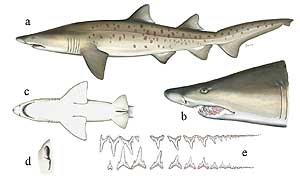
|
|
|
|
|
|
Shark Info (03-15-2000) |
Author |
|
Intro: |
Shark Info |
|
Main article: |
Andrew Cobb |
|
Article 1: |
Prof. H. Greven |
|
Article 2: |
Prof. M. S. Shivji |
|
Fact Sheet: |
Dr. E. K. Ritter |
|
Fact Sheet: Sand Tiger Sharks
The sand tiger shark (Carcharias taurus) is one species of shark which has been chased and slaughtered simply because of its threatening appearance. This harmless species has been practically extinguished in individual regions of the world and it remains to be seen if the protective measures introduced in several countries will prove to be effective.
The biology of the sand tiger shark (Carcharias taurus)Every year sand tiger sharks undertake long migrations. This means they always appear seasonally - normally within a specific time period of several weeks - at the same places. Their ocean habitat ranges to a depth of approximately 200 meters and they are usually nocturnal. Based on current knowledge, the sand tiger shark is the only shark species which swims to the water's surface and swallows air in order to regulate its buoyancy, enabling the animal to move around and remain at any desired depth. Although they are very strong, they appear lethargic and tend to swim slowly. Appearance and identifying marksThe physical appearance of a sand tiger shark strongly reflects the many prejudices which people tend to have about sharks: large, with permanently visible, long and dagger-formed teeth. In reality, however, sand tiger sharks are completely harmless. They have extremely small eyes but no Nickhaut (a third eyelid which it can pull over its eyes, a feature found, e.g. with gray sharks). In addition to its prominent teeth, its equally sized dorsal finds are considered another typical feature. Sand tiger sharks are light brown in color, with bronze- colored backs, a white abdomen and very often red spots on its flanks. SizeSand tiger sharks can grow to a length of more than 300 cm. Males and females are sexually mature when they reach a length of approximately 220 cm. Juveniles are born alive and measure approximately 100 cm in length at birth. Feeding HabitsSand tiger sharks prefer to feed on fish such as herring, snappers/Schnapper, eels, mackerels or other fish, and in rare cases, some smaller shark species. According to reports this species also goes hunting together, driving together swarms of fish and thus making them easy prey. ReproductionThe sand tiger shark has an unusual method of reproduction. During its embryonal phase, the more developed embryos eat up their less developed siblings. In this way only the two strongest young - one per uterus - survive and are born. At birth they measure one meter in length, which considerably increases their chances of survival since it reduces the number of their natural enemies. A similar strategy can be found with other shark species, whereby the embryos are not cannabilistic, but rather feed on less developed eggs found in the uterus. However, such strategies are only common with shark species who have no real uterus, for these would otherwise provide for a constant food supply. The length of gestation with sand tiger sharks is between 8 to 12 months. DistributionSand tiger sharks are found practically around the world in regions with moderate climates. They live in the western Atlantic from Maine to the Gulf of Mexico, but are not found in the Caribbean waters, although occasionally they are spotted around the Bahamas. Further territories include southern Brazil to Argentina, Bermuda, the Canary Islands and the Mediterranean. Around the African continent they are found mostly in South Africa and the Red Sea as well as Australia and Tasmania. BehaviorSand tiger sharks are often found in large groups which gather to mate or go hunting. Latest observations show that sand tiger sharks display a distinct social behavior. They like to linger socially underneath cliff overhangs or similar structures, remaining there motionless - with the help of swallowed air - for longer periods of time. Encounters with humansDespite their frightening appearance, sand tiger sharks are harmless animals which divers can get close to without hesitation. If one approaches them too closely they swim a couple of meters away and then stop. Since sand tiger sharks are very shy, their populations have been rapidly decimated as the first wave of "shark hysteria" hit humans. Especially in Australia this once led to an alarming reduction of their populations, while today they are protected. May be published only by indicating the source: Shark Info / Dr. Erich K. Ritter |
|
|
|
|
|
|||||
